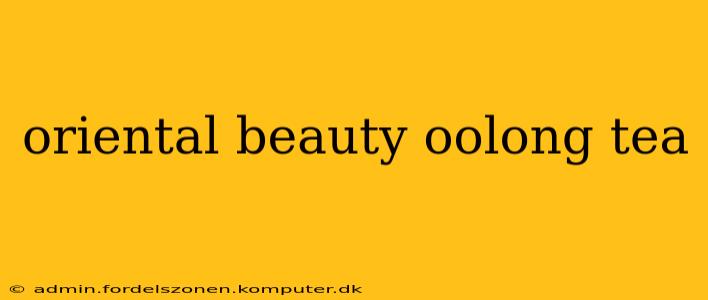Oriental Beauty Oolong tea, also known as Oriental Beauty, is a captivating and highly prized oolong tea with a unique flavor profile. Its distinctive character comes from a fascinating interaction between tea plants and tiny insects known as Jacobiasca formosana, or tea green leafhoppers. This interaction, along with careful processing, results in a luxurious cup that many consider a pinnacle of oolong tea excellence. This article will delve into the intricacies of this exceptional brew, exploring its origins, production, flavor characteristics, and health benefits.
What Makes Oriental Beauty Oolong Tea Unique?
Oriental Beauty Oolong's uniqueness stems from its production method. Unlike many oolongs, which rely solely on traditional withering, oxidation, and firing techniques, this tea involves a crucial step: the controlled infestation of tea leaves by the tea green leafhopper. These tiny insects feed on the leaves, causing a reaction that leads to a characteristically sweeter and more complex flavor profile. The resulting leaves are often visibly damaged, exhibiting a slightly mottled or speckled appearance.
How is Oriental Beauty Oolong Tea Made?
The production process for Oriental Beauty Oolong is intricate and requires precise timing and skilled craftsmanship. The process typically involves:
-
Leafhopper Infestation: Farmers carefully manage the infestation of tea leaves by the tea green leafhoppers during the summer months. The precise timing is crucial to achieve the desired level of damage and flavor complexity.
-
Harvesting: Leaves are harvested after the leafhoppers have done their work, typically in late summer or early autumn. The leaves are carefully selected, ensuring the right level of damage and quality.
-
Withering: The harvested leaves are gently withered to remove excess moisture, preserving their delicate flavor compounds.
-
Oxidation: This crucial step determines the level of oxidation and ultimately the tea's character. Oriental Beauty Oolong undergoes a moderate level of oxidation, contributing to its distinctive rich and fruity notes.
-
Rolling and Shaping: The leaves are rolled and shaped to create their characteristic appearance.
-
Firing: Finally, the leaves are fired (heated) to halt oxidation and preserve the tea's flavor and aroma.
What Does Oriental Beauty Oolong Tea Taste Like?
Oriental Beauty Oolong boasts a remarkably complex and nuanced flavor profile. Many describe it as having a rich, honeyed sweetness with hints of fruity notes like apricot, peach, and pear. The tea also often displays subtle floral aromas and a smooth, slightly creamy mouthfeel. The intensity of these flavors can vary depending on the specific growing conditions, processing techniques, and the degree of leafhopper damage.
What are the Health Benefits of Oriental Beauty Oolong Tea?
Like many oolong teas, Oriental Beauty is rich in antioxidants, which are believed to contribute to various health benefits, including improved cardiovascular health and boosted immunity. However, it's crucial to remember that while these teas have potential health advantages, more research is needed to confirm these benefits definitively. Always consult with a healthcare professional before making any significant dietary changes based on purported health benefits of tea.
Where Can I Buy Oriental Beauty Oolong Tea?
Oriental Beauty Oolong is a specialty tea, and thus not readily available in all stores. High-quality versions can often be found at specialty tea shops, online tea retailers, and some high-end grocery stores. Be sure to look for reputable sellers who can provide information on the origin and processing of their teas.
Is Oriental Beauty Oolong Tea Caffeinated?
Yes, Oriental Beauty Oolong tea contains caffeine, although the level is generally lower than that of black tea and higher than that of green tea. The caffeine content can also vary depending on factors like the processing method and growing conditions.
How Should I Brew Oriental Beauty Oolong Tea?
Brewing Oriental Beauty Oolong requires a gentler approach than some other teas. Using slightly cooler water (around 175-185°F or 80-85°C) and a longer steeping time (3-5 minutes) will help to extract the full range of flavor notes without bitterness. Multiple infusions are possible from a single batch of leaves, with each offering slightly different flavor nuances.
What is the Difference Between Oriental Beauty and Other Oolongs?
The key difference lies in the unique interaction with the tea green leafhoppers. This interaction profoundly impacts the flavor profile, resulting in the distinct sweet and fruity notes that characterize Oriental Beauty. Other oolongs, while also offering diverse flavor profiles, generally lack this particular characteristic sweetness and complexity brought about by the insect damage.
This exploration of Oriental Beauty Oolong highlights its unique production, rich flavors, and potential health benefits. While a specialty tea, its captivating qualities make it a rewarding experience for tea connoisseurs and curious drinkers alike. Enjoy the journey of discovery with this exceptional brew!
